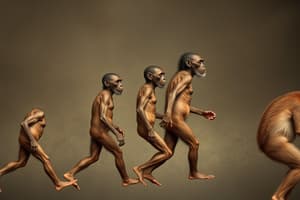Podcast
Questions and Answers
कौन-सा संस्कृत शब्द 'मानव जनन' का अर्थ है?
कौन-सा संस्कृत शब्द 'मानव जनन' का अर्थ है?
- मानव का विकास
- मानव के परिवार
- मानव की जीवनी
- मानव की उत्पत्ति (correct)
किस वर्ग के साथ मानव जाति का संकेत मिला?
किस वर्ग के साथ मानव जाति का संकेत मिला?
- Sahelanthropus tchadensis (correct)
- Arnold
- Archie
- Leo
Homo sapiens की प्राचीनतम प्रजाति कौन सी है?
Homo sapiens की प्राचीनतम प्रजाति कौन सी है?
- Homo habilis (correct)
- Homo neanderthalensis
- Homo erectus
- Homo denisova
Homo sapiens किससे सबसे पहले अलग हुए?
Homo sapiens किससे सबसे पहले अलग हुए?
Homo sapiens की मूल स्थानकों के बारे में किस का सुपरिचित सिद्धांत है?
Homo sapiens की मूल स्थानकों के बारे में किस का सुपरिचित सिद्धांत है?
Homo sapiens कहाँ से उत्पन्न हुए?
Homo sapiens कहाँ से उत्पन्न हुए?
कौनसी विकासनाव थ्योरी बताती है कि मानव सजीव अफ्रीका महाद्वीप और उसके पार, कई विभिन्न जनसंख्याओं से विकसित हुए थे?
कौनसी विकासनाव थ्योरी बताती है कि मानव सजीव अफ्रीका महाद्वीप और उसके पार, कई विभिन्न जनसंख्याओं से विकसित हुए थे?
किस गुण से हमारे पुर्खेगें मनुष्य के पूर्वाग्रह से परिपूर्ण होते गए?
किस गुण से हमारे पुर्खेगें मनुष्य के पूर्वाग्रह से परिपूर्ण होते गए?
मानव विकास में कौन-कौन से महत्वपूर्ण उन्नति शामिल हैं?
मानव विकास में कौन-कौन से महत्वपूर्ण उन्नति शामिल हैं?
मानव विकसिति में प्राकृतिक चुनाव की कितनी महत्वता होती है?
मानव विकसिति में प्राकृतिक चुनाव की कितनी महत्वता होती है?
कौन-सी संकेतन प्रणाली के उत्थान से हमारे पुर्खेगें सहयोग, योजना, और भविष्य की योजना कर सकते थे?
कौन-सी संकेतन प्रणाली के उत्थान से हमारे पुर्खेगें सहयोग, योजना, और भविष्य की योजना कर सकते थे?
किस चुनौती पर मानव विकसिति में होलने को संतुलित किया है?
किस चुनौती पर मानव विकसिति में होलने को संतुलित किया है?
Flashcards are hidden until you start studying
Study Notes
Unraveling Manav Janan: A Journey through Human Evolution
Human evolution is an intricate tale of genetic adaptations and biological developments that have unfolded over millions of years. Manav Janan, the Sanskrit term for "human origin," allows us to explore this story from a unique perspective, as we delve into the subtopics that shape our understanding of human evolution.
Early Hominids and Homo sapiens' Ancestry
The first hominids appeared around 6 to 7 million years ago, marked by Sahelanthropus tchadensis and Ardipithecus ramidus. The genus Homo, which includes our species, Homo sapiens, originated around 2.8 million years ago with Homo habilis. From there, our ancestors Homo erectus, Homo neanderthalensis, and Homo denisova emerged, each species displaying unique characteristics and adaptations. Homo sapiens, the most recent species, began to diverge from the other Homo species around 300,000 years ago, eventually replacing them.
Hypotheses on the Origins of Homo sapiens
The Out of Africa theory, one of the most widely accepted hypotheses, posits that Homo sapiens originated in Africa around 200,000 to 300,000 years ago and later migrated to Asia and Europe, eventually spreading to the rest of the world. A more recent hypothesis, the Multiregional Evolution theory, suggests that Homo sapiens developed from multiple, distinct populations across the African continent and beyond, leading to a more gradual mixing of genes and the spread of our species across the globe. Both theories have their advocates, and ongoing research continues to refine our understanding of human evolution.
Key Adaptations and Behaviors
As our ancestors evolved over time, they developed various adaptations that enabled them to adapt to their changing environments and improve their survival. Significant advances included:
- Bipedalism: The ability to walk on two legs, which freed up our ancestors' hands for manipulating tools and gathering resources.
- Tool use and manufacturing: The development and creation of stone tools, such as axes, knives, and scrapers, allowed our ancestors to better process food and communicate with each other.
- Language: The evolution of communication systems, including gestures, vocalizations, and eventually language, allowed our ancestors to share information, cooperate, and plan for the future.
- Culture: The development of social behaviors, group living, and cultural traditions allowed our ancestors to learn from each other's experiences and pass down knowledge from one generation to the next.
Challenges and Controversies
Human evolution is a dynamic and ever-evolving field of study. Researchers continue to debate various aspects of our origins, including:
- Interbreeding between ancestral species and Homo sapiens: The degree to which our ancestors interbred with other hominid species, such as Neanderthals and Denisovans, and the genetic impact of these encounters is still hotly debated.
- The role of natural selection in human evolution: The extent to which genetic mutations and environmental pressures have driven the evolution of our species is a subject of ongoing debate.
- The impact of climate change on human evolution: The relationship between climate change and the emergence of new hominid species and adaptations is a topic of significant research.
Conclusion
Human evolution is a fascinating and complex topic, one that continues to captivate and inspire scholars and enthusiasts alike. Through examining the development of our ancestors, from the earliest hominids to the modern-day Homo sapiens, we gain insights into our past, understand our present, and glimpse into our future. The story of Manav Janan offers a unique perspective on our origins and provides a framework for ongoing research into human evolution, behavior, and culture.
Studying That Suits You
Use AI to generate personalized quizzes and flashcards to suit your learning preferences.




